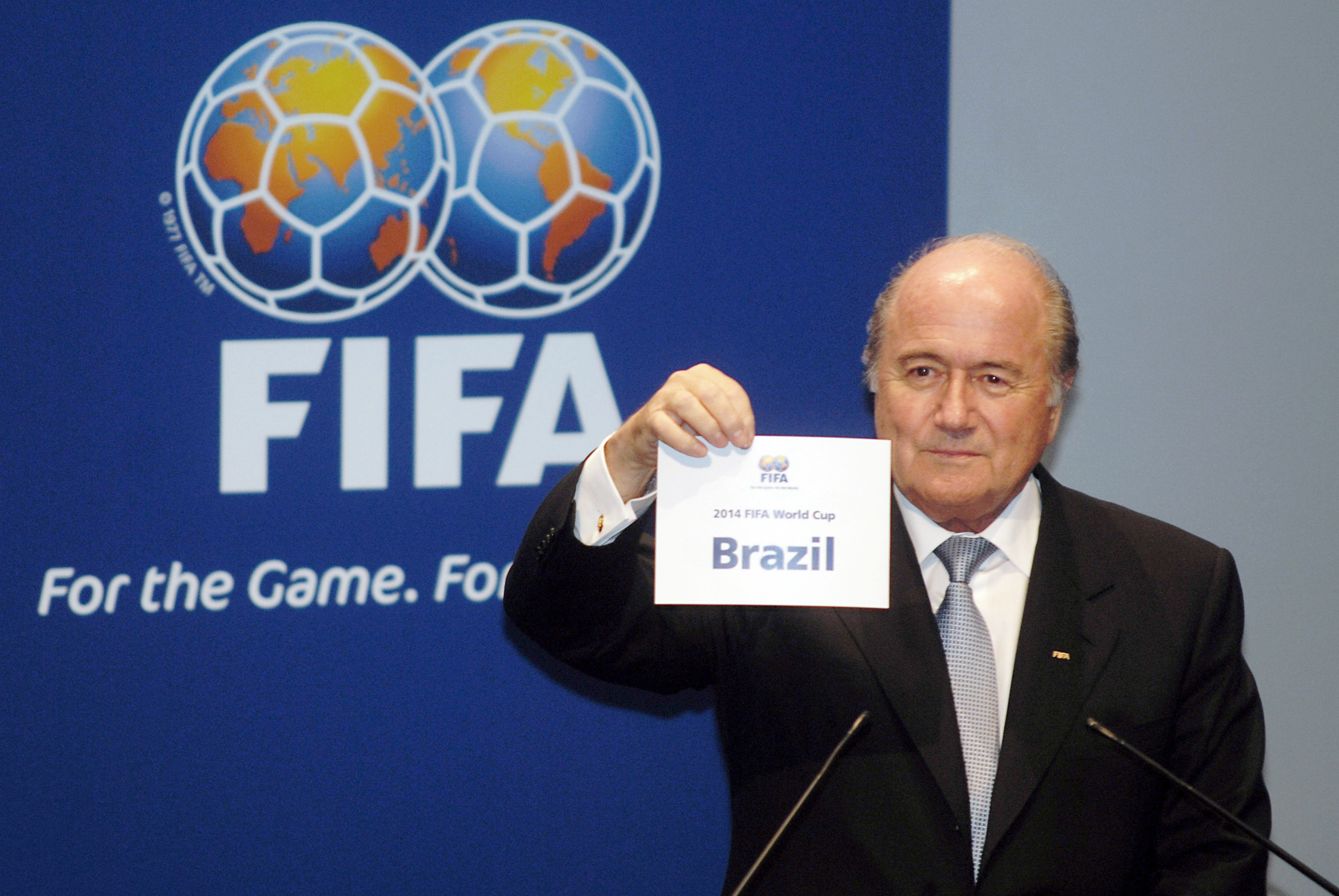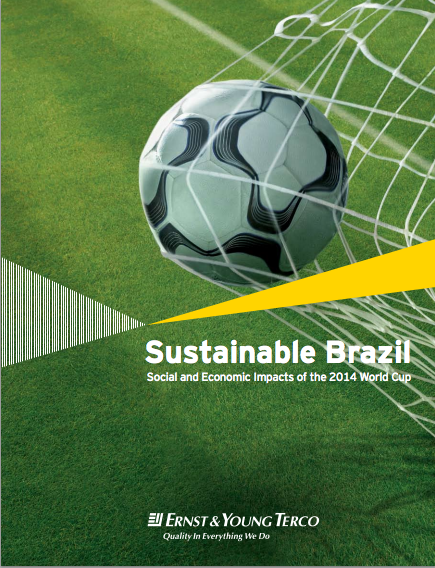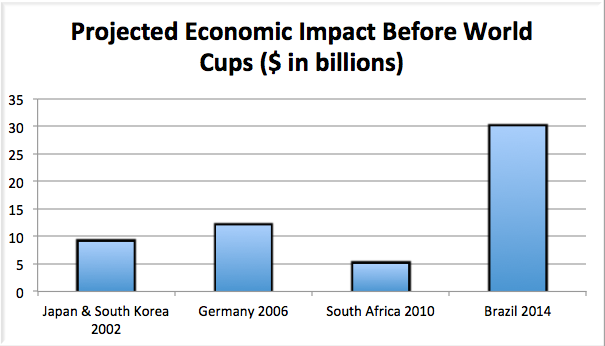Return to Why Canada? main page
By Shiv Gidumal
Why Bid for the World Cup?
“A FIFA World Cup brings revenue opportunities, albeit depending on the efforts of the member association, through ticketing revenues, government and private funding, FIFA subsidy funding, food and beverage concessions and partnerships with national supporters,” FIFA claims in a brochure encouraging countries to host competitions other than the Men’s World Cup [1].

Picture courtesy of Wikimedia
One of these “Other” World Cups is FIFA’s quadrennial Women’s World Cup, widely considered the most important tournament in women’s soccer.
Yet, when Canada first entered the race to host the Women’s World Cup, they faced only one competitor, Zimbabwe [2]. Soon after, Zimbabwe withdrew and Canada became the host by default. They were the only country that sought to host the women’s soccer tournament [3].
Surprisingly, not many countries have submitted bids to host the tournament, despite many arguments that World Cups have a dramatically positive economic impact on the host country.
“A FIFA World Cup brings revenue opportunities, albeit depending on the efforts of the member association, through ticketing revenues, government and private funding, FIFA subsidy funding, food and beverage concessions and partnerships with national supporters.”[1]
As a result, we wanted to answer a few questions about the economic consequences of hosting:
Do these massive tournaments definitively boost a host country’s economy?
How does the women’s World Cup differ from the men’s in its economic impact?
Finally, how should we think about the impact of the 2015 Women’s World Cup on Canada’s economy?
Do these massive tournaments definitively boost a host country’s economy?
The most recent men’s World Cup, the 2014 tournament, has faced the most scrutiny as people analyze its effect on Brazil’s economy.
In 2007, Brazil won the right to host the Men’s World Cup. Similar to the bidding process for the 2015 women’s tournament, the winner was determined by default after one of only two remaining bidders, Colombia, dropped out [4]. However, unlike the women’s tournament, FIFA limits potential bidders by rotating the host continent each year, with 2014’s World Cup belonging to South America [5].
Leading up to Brazil’s World Cup, it seemed obvious that the tournament positively impacted the host’s economy.
In 2002, Japan & South Korea projected a $9b positive impact [6], while Germany and South Africa estimated $12b [7] and $5b [8] in 2006 and 2010, respectively. As a result, when Ernst & Young, an accounting firm, analyzed the 2014 tournament, they had extremely optimistic expectations.

Picture courtesy of Ernst & Young’s report.
Their report estimated that the World Cup would add nearly $30 billion to Brazil’s GDP in the four years leading up to the tournament [9]. Moreover, they projected an additional 3.63 million jobs and 3.7 million tourists, who would spend an average of $2,488 [10].
Indeed, many analysts agreed that the World Cup helps the host country’s economy, particularly by boosting job growth and tourism.
Yet, four years after the 2010 World Cup, the South African economy appeared to have been harmed by hosting the tournament. CNN reported that South Africa lost $3.9 billion due to the games, which amounts to nearly $13,000 per spectator [11].
Similarly, many metrics suggest that Brazil’s economic performance has declined due to the 2014 competitions.
“I think that [the World Cup] was a net positive, but nothing like what people imagined.”[14]
According to an article in the Wall Street Journal, Brazil’s National Confederation of Industry (CNI) reported in the weeks following the World Cup that the leading gauge of industrial production fell to its lowest levels ever recorded [12]. Furthermore, “undesired” inventories soared and capacity utilization fell to 68% [13].
Jankiel Santos, a leading economist at Epirito Santo Investment Bank in Sao Paolo, believed that the country wasted a huge opportunity with the tournament, claiming, “What we really need is greater production capacity, and that capacity only comes through investment. I think that [the World Cup] was a net positive, but nothing like what people imagined. At the end of the day what we wanted from hosting the Cup were improvements to infrastructure that were promised but not delivered” [14].
_12.jpg)
Picture of Copacabana protest courtesy of Wikimedia.
After 2002 and 2006, years of successful World Cups, it is clear that host countries can help their economies. However, reflection on 2010 in South Africa forces us to question the true value of hosting. While it is unclear whether Brazil helped its economy by hosting, the economically developing South American nation demonstrated that hosts can get in their own way as they prepare for the competition. Although the jury is still out on the 2014 World Cup, nations should look at some of Brazil’s shortcomings and learn from its experience.
How does the women’s World Cup differ from the men’s in its economic impact?

Picture courtesy of Kobe Bryant’s Twitter.
One of the most controversial and widely known stories of the 2015 World Cup was the women’s lawsuit against FIFA regarding the type of turf used at the tournament in Canada [15]. The women argued that they were not being given the same treatment as the men because the two World Cups utilized completely different fields. In addition to the types of turf, the tournaments differ greatly in their economic impact on the host country.
In 2011, women’s soccer made headlines when ESPN reported that the World Cup final between the U.S. and Japan, a penalty shoot-out that many consider among the best games in women’s tournament history, attracted 14.1 million viewers in the U.S [16]. The game set records in the United States for the most watched football match ever broadcast by ESPN [17]. In contrast, the most watched men’s game, U.S.A. vs. Ghana in 2014, attracted only 11.1 million [18].
.jpg)
Alex Morgan during the widely watched 2011 World Cup Final in Germany. Courtesy of Wikimedia.
This record-breaking match sparked hopes for massive turnout and revenues at the 2015 World Cup. However, the projections for the women’s tournament pale in comparison to the men’s.

The scattered crowds at the Summer 2012 Olympic Women’s Soccer Final do not come close to filling the stadium. Courtesy of Wikimedia.
While the men’s tournament discussed projections in terms of billions of dollars, the women’s World Cup remains in the millions. The numbers for the Women’s World Cup simply don’t have the same number of zeroes as the men’s tournament.
How should we think about the impact of the 2015 Women’s World Cup on Canada’s economy?

Courtesy of CSA’s published report
The Canadian Soccer Association (CSA), using the Sport Tourism Economic Assessment Model, estimates the World Cup will support up to $267.3 million in Canadian economic activity [19]. The GDP should be boosted by a total of $132 million [20].
However, although it recognizes that Canada’s numbers aren’t even in the same ballpark as Brazil’s, the CSA still aspires to host the most successful Women’s World Cup ever. While this implies just 1.5 million spectators [21], less than half of the 3.5 million at Brazil [22], Canada would have hosted the largest FIFA event outside of the men’s World Cup.
In the CSA’s Leading a Soccer Nation: Strategic Plan, the association discusses some of the goals of the World Cup. Some of these objectives include, “Work closely with the federal government as well as other funding organizations to seek out commercial partnering opportunities” and “Actively engage in business development through marketing partnerships and the procurement of new and existing corporate sponsors and partnership agreements” [23].

Image courtesy of MCK Global
More importantly, the nation as a whole wants to “elevate the profile of soccer in the country” so that they can “successfully prepare and submit a bid to host the 2026 FIFA World Cup” [24]. The Canadian association would definitely raise their profile in the soccer world if they reach their goals as host of the 2015 World Cup. Even more importantly, a successful Women’s World Cup in 2015 would clearly show FIFA the organizational skills and foundational infrastructure necessary to host a Men’s World Cup in 2026.
Indeed, although the 2015 World Cup’s contribution of $132 million is just a drop in the ocean of Canada’s $1.8 trillion GDP [25], we can view the economic impact of the tournament as an investment towards greater returns from potential hosting opportunities in the future. Furthermore, if Canada can run its competitions more cheaply and effectively than Brazil, the nation could reap greater rewards and grow its economy and infrastructure more.
The nation as a whole wants to “elevate the profile of soccer in the country” so that they can “successfully prepare and submit a bid to host the 2026 FIFA World Cup.”[24]
Truly, the 2015 World Cup could dramatically affect the Canadian economy for years to come.
How to cite this page: “The Economics of Canada’s 2015 World Cup” Written By Shiv Gidumal (2015), World Cup 2015, Soccer Politics Blog, Duke University, http://sites.duke.edu/wcwp/world-cup-guides/world-cup-2015-guide/why-canada/the-economics-of-hosting-the-womens-world-cup/ (accessed on (date)).
Bibliography
1. “The Benefits of Hosting FIFA’s Other World Cups.” Bid Collateral Brochure. Accessed April 12, 2015. http://www.fifa.com/mm/document/tournament/bid.otherevents/01/30/02/09/bidcollateralbrochure_sebcs4.pdf.
2. CBC.ca. 2015. ‘Canada In Mix For 2015 Women’s World Cup’. Accessed April 20 2015. http://www.cbc.ca/sports/soccer/canada-in-mix-for-2015-women-s-world-cup-1.987026.
3.News.bbc.co.uk,. 2015. ‘BBC Sport – Football – Zimbabwe Withdraws Bid To Host 2015 Women’s World Cup’. Accessed April 20 2015. http://news.bbc.co.uk/sport2/hi/football/africa/9410484.stm.
4. Fifa.com,. 2007. ‘Brazil Confirms Bid – Colombia Withdraws – FIFA.Com’. Accessed April 20 2015. http://www.fifa.com/world-match-centre/news/newsid/123/706/index.html.
5. Fifa.com,. 2003. ‘2014 FIFA World Cup TM To Be Held In South America – FIFA.Com’. Accessed April 20 2015. http://www.fifa.com/newscentre/news/newsid=85909/index.html.
6. News.bbc.co.uk,. 2002. ‘ BBC News | ASIA-PACIFIC | S Korea Hopes For World Cup Lift’. Accessed April 20 2015. http://news.bbc.co.uk/2/hi/asia-pacific/1896887.stm.
7. Maurer, Daniel. 2006. ‘Germany Hopes World Cup Will Boost Economy’. Com. Accessed April 20 2015. http://www.nbcnews.com/id/12303396/ns/business-world_business/t/germany-hopes-world-cup-will-boost-economy/#.VTRI5K1Vikp.
8. Simmonds, Commerzbank. 2015. ‘Commerzbank AG – Corporates & Markets- Press Release 2010’.Commerzbank.Com. Accessed April 20 2015. https://cbcm.commerzbank.com/media/documents/information_and_news/press_releases/2010/wm100601e.pdf
9.Ernst & Young, “Sustainable Brazil: Social and Economic Impact of the 2014 World Cup.” 2011. Accessed April 20 2015. http://www.ey.com/Publication/vwLUAssets/Sustainable_Brazil_-_World_Cup/%24FILE/copa_2014.pdf.
10. Ibid.
11. Egan, Matt. 2015. ‘South Africa’s World Cup Warning To Brazil’. Cnnmoney. Accessed April 20 2015. http://money.cnn.com/2014/06/09/investing/world-cup-south-africa-brazil/.
12. Paul, Kiernan. 2015. ‘World Cup Hit Brazil’S Economy Hard’. Accessed April 20 2015. http://blogs.wsj.com/moneybeat/2014/07/18/world-cup-hit-brazils-economy/.
13. Ibid.
14. Ibid.
15. espnW,. 2015. ‘Abby Wambach, Players Withdraw Women’s World Cup Lawsuit Over Use Of Artificial Turf’. Accessed April 20 2015. http://espn.go.com/espnw/news-commentary/article/12205330/abby-wambach-players-withdraw-women-world-cup-lawsuit-use-artificial-turf.
16. Fifa.com,. 2011. ‘FIFA Women’S World Cup Germany 2011 Sets New TV Viewing Records – FIFA.Com’. Accessed April 20 2015. http://www.fifa.com/tournaments/archive/womensworldcup/germany2011/news/newsid=1477957/index.html.
17. Ibid.
18. Fifa.com,. 2014. ‘TV Viewing Breaks Records In First FIFA World Cup Matches ‘. Accessed April 20 2015. http://www.fifa.com/worldcup/news/y=2014/m=6/news=tv-viewing-breaks-records-in-first-fifa-world-cup-matches-2378078.html.
19.Canadasoccer.com,. 2014. ‘Economic Impact Of Upcoming FIFA Competitions In Canada Expected To Exceed $337 Million | Canada Soccer’. Accessed April 20 2015. http://www.canadasoccer.com/economic-impact-of-upcoming-fifa-competitions-in-canada-expected-to-exceed-337-million-p155877.
20.Ibid.
21. Vaidyanath, Rahul. 2014. ‘FIFA Women’s World Cup In 2015 Thrusts Canada Onto International Stage’. The Epoch Times. Accessed April 20 2015. http://www.theepochtimes.com/n3/937014-fifa-womens-world-cup-in-2015-thrusts-canada-onto-international-stage/
22. Statista. 2015. ‘Number Of Spectators At The Soccer World Cup 1930-2014 | Statistic’. Accessed April 20 2015. http://www.statista.com/statistics/264441/number-of-spectators-at-football-world-cups-since-1930/.
23. Canadian Soccer Association. 2014. Leading a Soccer Nation: Strategic Plan. Accessed April 20 2015. http://www.canadasoccer.com/files/CanadaSoccer_StrategicPlan2014_2018_EN.pdf.
24. Ibid.
25. Google.com,. 2015. ‘World Development Indicators – Google Public Data Explorer ‘. Accessed April 20 2015. https://www.google.com/publicdata/explore?ds=d5bncppjof8f9_&met_y=ny_gdp_mktp_cd&idim=country:CAN:AUS:GBR&hl=en&dl=en.


Intriguing read – had hoped to see comparison of Germany 2011 to Canada 2015 — on sponsorship alone 2015 well behind, having signed only 2 real partners and not early on enough for them to generate ripple effect in the economy. Est for Germany was $24 mil in sponsor revenue.
Am also curious to understand the ticket revenue Canada will realize. What is the Cdn ‘take’ on tickets sold outside Canada. As US were significant buyers are they getting a cut?
Finally, merchandise was quite thin in assortment, availble late and hard to come by – wondering how this compares – I understand Germany netted $4 million in merch
Feel free to correspond on this.
This is a really in-depth look at the question, with terrific illustrations. I like how you connect the Canadian case to the Brazil case but also offer a sense of the specifics of this case as well. Really well done all around.
This is a small thing but do you have numbers on post-World Cup effects in South Korea and Germany? You said they were successful but how did it compare to the projections and is there any noticeable difference in why they were successful but South Africa, and arguably Brazil, were not?